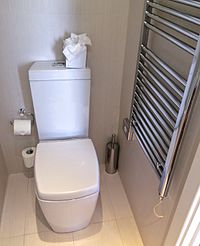
Photo from wikipedia
Water electrolysis has been considered as one of the most efficient approaches to produce renewable energy, although efficient removal of gas bubbles during the process is still challenging, which has… Click to show full abstract
Water electrolysis has been considered as one of the most efficient approaches to produce renewable energy, although efficient removal of gas bubbles during the process is still challenging, which has been proved to be critical and can further promote electrocatalytic water splitting. Herein, a novel strategy is developed to increase gas bubble escape rate for water splitting by using nonwoven stainless steel fabrics (NWSSFs) as the conductive substrate decorated with flakelike iron nickel-layered double hydroxide (FeNi LDH) nanostructures. The as-prepared FeNi LDH@NWSSF electrode shows a much faster escape rate of gas bubbles as compared to that of other commonly used three-dimensional porous catalytic electrodes, and the maximum dragging force for a bubble releasing between NWSSF channels is only one-seventh of the dragging force within nickel foam channels. As a result, it exhibits excellent electrocatalytic performance for both oxygen evolution reaction (OER) and hydrogen evolution reaction (HER), with low overpotentials of 210 and 110 mV at the current density of 10 mA cm-2 in 1 M KOH for OER and HER, respectively. There is almost no current drop after a long-time durability test. In addition, its performance for full water splitting is superior to that of the previously reported catalysts, with a voltage of 1.56 V at current density of 10 mA cm-2.
Journal Title: ACS applied materials & interfaces
Year Published: 2017
Link to full text (if available)
Share on Social Media: Sign Up to like & get
recommendations!